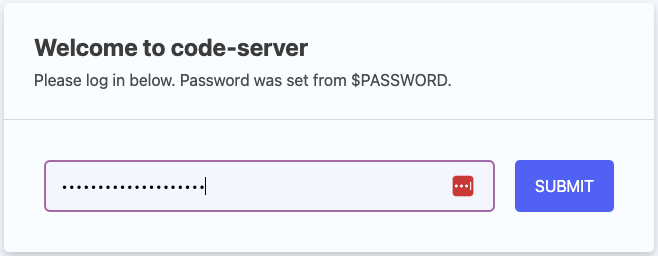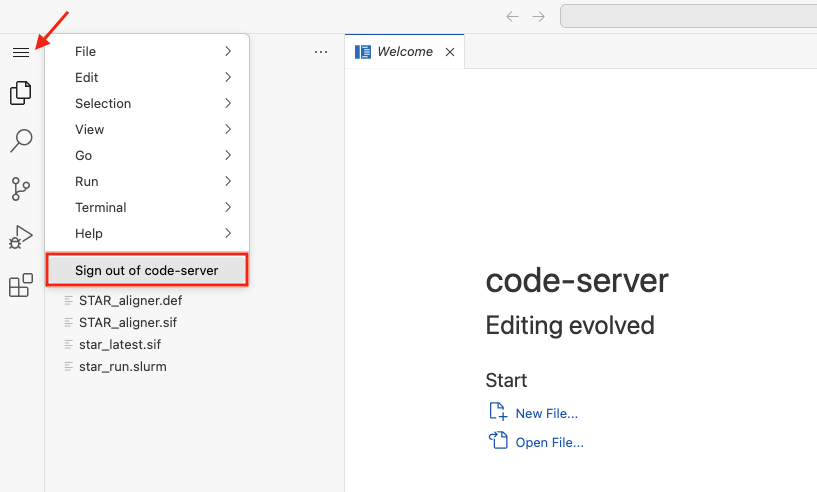VS Code via Code-Server
This solution:
-
Provides a method to connect VS Code to a compute node on
klone, preserving the login nodes for the community. As a reminder, we prohibit users running processes on the login node. -
Uses a server to develop and execute your code reducing battery usage.
code-serverhandles the VSCode background processes, preventing them from slowing down your local machine. -
Provides a simpler alternative to VS Code via ProxyJump, which requires a lot of setup and for Windows users requires 2-factor authentication to login and change directory.
-
Involves steps: making a symbolic link to the container stored on hyak or pulling the docker container yourself, launching a batch job to start the container on a compute node, opening a SSH tunnel to the compute node where the container is running, and securely accessing VS Code through your browser window.
Accessing the Container
This step only needs to be performed during initial set up.
We have pulled a version of the code-server container for our users. This removes 5 minutes of set up, and allows use of the container without occupying user disk storage.
First, navigate to a directory a where you will store your symbolic link to the code-server container. In this example, we will navigate to our home directory.
cd $HOME
Create a symbolic link to the container which we have stored for you in /mmfs1/sw/containers/code-server/. The symbolic link shortcut will appear in the directory where the command was initiated, unless otherwise specified.
ln -s /mmfs1/sw/containers/code-server/code-server_4.89.0-39.sif code-server_4.89.0-39.sif
# Now you can use the code-server container from your directory
# rather than specifying the entire path to our version of the container.
This will link to code-server container version 4.89.0-39. There are other versions of the container you might consider: code-server tags, and below, we include optional instructions for pulling the latest version of code-server.
This step only needs to be performed during initial set up.
Start an interactive job to pull the container with the apptainer module. Here is an example command to start your interactive job (find out which accounts and partitions your can access with the hyakalloc command):
salloc --partition=ckpt --cpus-per-task=1 --mem=16G --job-name=code-server --time=2:00:00
Pull the container from DockerHub. This will take a few minutes to complete. When complete, you will have a container image called code-server_lastest.sif. There are other versions of the container you might consider rather than the latest version: code-server tags.
apptainer pull docker://codercom/code-server
Launch code-server with Slurm
Download the Slurm batch script.
wget https://hyak.uw.edu/files/code-server.job
Edit the job script (find comments "#update this line") to set your code-server session home directory and provide the name of the container if it does not match code-server_latest.sif, and edit the SBATCH directives as needed. The code block below shows the lines that should be updated as needed.
# To identify accounts and partitions that are available to you, use the hyakalloc command
#SBATCH --partition=ckpt # update this line
#SBATCH --time=02:00:00 # update this line to change time limit
# Set home destination for code-server session
CODER_HOME="/gscratch/scrubbed/UWNetID" # update this line
# Provide container file
CODER_SIF="code-server_4.89.0-39.sif" # update this line if needed
Submit the script with sbatch. Repeat this step and all following steps each time you log in and connect to VS Code.
sbatch code-server.job
Submitted batch job 12345678
This script will start a batch job and launch the code-server container. The SSH tunneling instructions, including the code-server session password, will be written to the output file (stdout), for example code-server.job.12345678 would be the output file in here where 12345678 is our fictional Job ID--the JobID for your output file will be different. Concatenate (cat) the output file for tunneling instructions. The following is an example output.
cat code-server.job.12345678
1. SSH tunnel from your workstation using the following command:
ssh -N -L 8080:n3088:59985 UWNetID@klone.hyak.uw.edu
and point your web browser to http://localhost:8080
2. log in to Code Server using the following credentials:
password: +WwYzgh7YH/yHzUWNWNS
When done using Code Server, terminate the job by:
1. Sign out of Code Server (Find the three-lines icon Menu and select "Sign out of Code Server")
2. Issue the following command on the login node:
scancel -f 12345678
Monitor the job with squeue and your UWNetID like the following example.
squeue -u <UWNetID>
JOBID PARTITION NAME USER ST TIME NODES NODELIST(REASON)
12345678 compute code-ser UWNetID R 3:15 1 n3088
The output file (code-server.job.12345678 in this example) will also contain messages from code-server as the connection is established. These messages include:
- The storage location of session associated files -
~/.local/share/code-serverin your home directory. - The location of the configuration file for the session which contains the password that is also printed in the output file -
~/.config/code-server/config.yamlin your home directory. - Which IP and Port
code-serverHTTP and session is listening to.
As your session continues, more information will be printed to this output file.
Establish the SSH tunnel
Follow the instructions in the output file. Open a new terminal/powershell/PuTTy window ON YOUR COMPUTER and use your version of the tunnel command from your job output file (e.g., code-server.job.12345678). The following is an example:
ssh -N -L 8080:n3088:59985 UWNetID@klone.hyak.uw.edu
... provide UWNetID password
... Duo 2 Factor Authentication
The login will appear to hang, but your connection is now open.
Do not use the code-server password to open the ssh tunnel. After your ssh command, your UWNetID password is required. Multiple failed login attempts will result in a IP ban.
Open a new browser window to http://localhost:8080 and provide the password from the output file (code-server.job.17440706 and +WwYzgh7YH/yHzUWNWNS in this example).

Extensions can be installed through the browser and will be stored in ~/.local/share/code-server/extensions in your home directory.
End the Session
To end your session, find the three-lines icon Menu and select "Sign out of Code Server."

And end the batch job with scancel and the JobID on klone like the following example.
scancel -f 12345678
If you have trouble with this method, please report errors in an email to help@uw.edu with Hyak in the message.